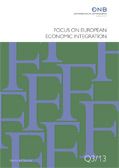Focus on European Economic Integration Q2/15
 OeNB
OeNB
- published:
- June 2015.
 OeNB
OeNB
Call for entries: Olga Radzyner Award 2015 (PDF, 51 kB) Focus on European Economic Integration Q2/15 en Jun 30, 2015, 12:00:00 AM
Call for applications: Visiting Research Program (PDF, 50 kB) Focus on European Economic Integration Q2/15 en Jun 30, 2015, 12:00:00 AM
Developments in selected CESEE countries: Gradual recovery in CESEE EU Member States continues, moderate growth in Turkey, stagnation in Russia (PDF, 814 kB) Focus on European Economic Integration Q2/15 en Jun 30, 2015, 12:00:00 AM
Outlook for selected CESEE countries: Steady growth in CESEE-6, deep recession in Russia (PDF, 219 kB) Focus on European Economic Integration Q2/15 en Jun 30, 2015, 12:00:00 AM
Bridging the information gap: small-scale nowcasting models of GDP growth for selected CESEE countries (PDF, 466 kB) Feldkircher, Huber, Schreiner, Tirpák, Tóth, Wörz. Martin Feldkircher, Florian Huber, Josef Schreiner, Marcel Tirpák, Peter Tóth, Julia Wörz – Focus on European Economic Integration Q2/15 In this article, we describe short-term forecasting models of economic activity for seven countries in Central, Eastern and Southeastern Europe (CESEE) and compare their forecasting performance since the outbreak of the Great Recession. To build these models, we use four variants of bridge equations and a dynamic factor model for each country. Given the differences in availability of monthly indicators across countries and the rather short time period over which these indicators are available, we favor small-scale forecasting models. We selected monthly indicators on the basis of expert judgment, correlation analysis and Bayesian model averaging techniques. While our models generally outperform a purely time series-based forecast for all CESEE countries, there is no single technique that consistently produces the best out-of-sample forecast. To maximize forecasting accuracy, we therefore recommend selecting a country-specific modeling approach for every CESEE economy on the basis of out-of-sample forecasting performance. en nowcasting,bridge equations,dynamic factor models,Bayesian model averaging,Central,Eastern and Southeastern Europe C52, C53, E37 Jun 30, 2015, 12:00:00 AM
What can we learn from Eurosystem Household Finance and Consumption Survey data? – An application to household debt in Slovakia
(PDF, 863 kB)
Fessler, Jäger-Gyovai.
Fessler, Jäger-Gyovai, Messner – Focus on European Economic Integration Q2/15
This study delivers a stock-taking exercise of household debt in Slovakia. About 27% of all
Slovak households hold at least some debt. The rate of homeownership in Slovakia is close to 90% and the highest in the euro area, while the share of indebted households is lowest. The reason for this peculiarity lies in the country’s history. Less than 10% of households are mortgage debt holders, and about 20% hold nonmortgage debt. About 15% of total debt holdings are covered by liquid financial assets and about 50% by households’ total assets excluding the main residence. When accounting only for the debt of vulnerable households, the share of total debt not covered by households’ total assets excluding the main residence lies between about 4% and 15% – depending on the definition used for debt burden measures. In Slovakia, mostly households with relatively young household heads are indebted. Regression analyses show that while self-employed persons and persons with higher education are more likely to hold debt, especially the self-employed are less likely to be vulnerable.
en
household indebtedness,ability to pay,microdata
D10, D14, D31, D39, E44, E17
Jun 30, 2015, 12:00:00 AM
CESEE-Related Abstracts from Other OeNB Publications (PDF, 86 kB) en Jun 30, 2015, 12:00:00 AM
Conference: “The Western Balkans: 15 Years of Economic Transition” (PDF, 107 kB) Focus on European Economic Integration Q2/15 en Jun 30, 2015, 12:00:00 AM
Statistical annex (PDF, 131 kB) Focus on European Economic Integration Q2/15 en Jun 30, 2015, 12:00:00 AM
Notes (PDF, 127 kB) en Jun 30, 2015, 12:00:00 AM